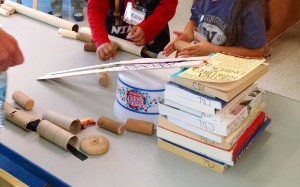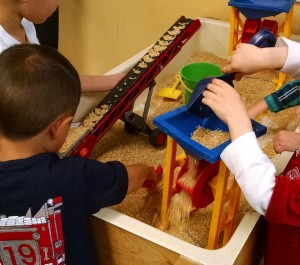An updated version of this post can be found here: https://inventorsoftomorrow.com/2016/09/26/inclined-planes-2/

In our first session on Simple Machines, we covered inclined planes.
The key point to inclined planes is that it takes less work to move a load, but it travels over a longer distance. You could give kids a heavy load and ask them to lift it straight up to a table, shelf, or platform on a slide. Then give them a steep ramp to push it up. Then give them a much longer, and not so steep ramp. Which is easiest/the least work?
The way we illustrated this was with a step ladder, a stuffed elephant, and a board. “Can this elephant climb up to the top platform on the ladder? No! What if we put this steep ramp here? Now can it do it? Yes, but it’s a really steep hill. What if we put this long, not-so-steep board here? Now it’s much easier. The elephant has to walk much further, but it’s an easy walk.”
How Much Work? Tie buckets to toy cars. Set up a shallow ramp by propping a board on some books. Drape the bucket over the end of the ramp. Drop pennies or marbles into the bucket. How many pennies does it take for the weight to pull the car to the top of the ramp? Now set up a steeper ramp. How many pennies (i.e. how much work) to pull the car to the top? This idea and photo are from the book Simple Machines by Deborah Hodge.
Note: Learning Resources has a Force & Motion Activity Set that lets kids experiment with pendulums and inclined planes. I have not seen it, but the pictures look like the kit provides materials you could use for this activity. I personally prefer making experiments from materials everyone has in their home rather than buying special equipment, but you may prefer pre-fab.
Art and Experience: We had kids decorate their own inclined planes (wooden paint stirrers) with markers and bingo daubers. Then they could prop them up on stacks of books, and roll cylinder blocks down them (see picture at top of post). It was a great way to test the idea that the steeper the ramp, the faster they roll. (Notice in the picture below the barriers we set up to keep them on the table! We hadn’t done that in advance, but luckily a dad jumped in to solve the problem of them rolling across the floor.)

Egg Roll: Another way ramps can be used is to make a trip downwards more gentle. A great way to illustrate this would be to drop an egg into a pan from 6 – 12″ high. It would break. Ask: how could I lower this in more gently? Then use a non-steep ramp to slide it gently down into the pan. We didn’t do this in class, because we didn’t want a bunch of broken eggs! But it’s a fun opportunity for an experiment while cooking.
Sensory Tub: We had a conveyor belt toy, and kids could crank the wheel (another simple machine) to create a pulley action to move rice up an inclined plane. You could also just put some pieces of bamboo cut into a gutter shape or paper towel tubes cut in half lengthwise to form ramps to pour rice down.
Tinkering Project: We had the marble run set up to explore.
Free Play: Our toy garage has inclined planes (ramps) to drive cars up and down, and an elevator on a pulley (two simple machines in one toy).
Big Motor: We have a small slide (inclined plane) we set up indoors. We also had two wedge shaped mats and one triangle mat. Kids set up obstacle courses, and discovered that it’s much easier to climb up the non-steep wedge than up the steep triangle.

Follow-Up Activities: Parents can then spend the next week asking their child to notice inclined planes in their world. The easiest example to show is a moving van or delivery truck: instead of standing next to the truck’s platform and lifting a box high up onto a platform, the worker walks up a ramp – it’s a longer distance, but less work. They can help their children notice ramps and hills: “This is a steep hill. It’s hard to climb up.” “Be careful riding your bike down that hill. It will make you go faster.”
My four-year-old wanted to move a big box up the stairs this week – it was big enough to slide up because it spanned a couple treads – and talked a lot about how having the inclined plane helped him move big heavy things.





[…] Concept of Wedges: A wedge is two inclined planes, brought together in a sharp edge. You place that sharp edge on an object you want to cut or […]
LikeLike
[…] have not played it. Over the next few weeks, I will add posts about each of the simple machines. Inclined Planes, Pulleys, Wedges, Levers, Screws, Wheels & […]
LikeLike
[…] can use to push over that first Domino in the chain. Examples we had were our Conveyor Belt from inclined planes week, our Wrecking Ball and pull-back car from Towers week, and a tube that you could aim at the […]
LikeLike
[…] concept of wedges: A wedge is two inclined planes, brought together in a sharp edge. You place that sharp edge on an object you want to cut or […]
LikeLike
[…] can use to push over that first Domino in the chain. Examples we had were our Conveyor Belt from inclined planes week, our Wrecking Ball and pull-back car from Towers week, and a tube that you could aim at the […]
LikeLike